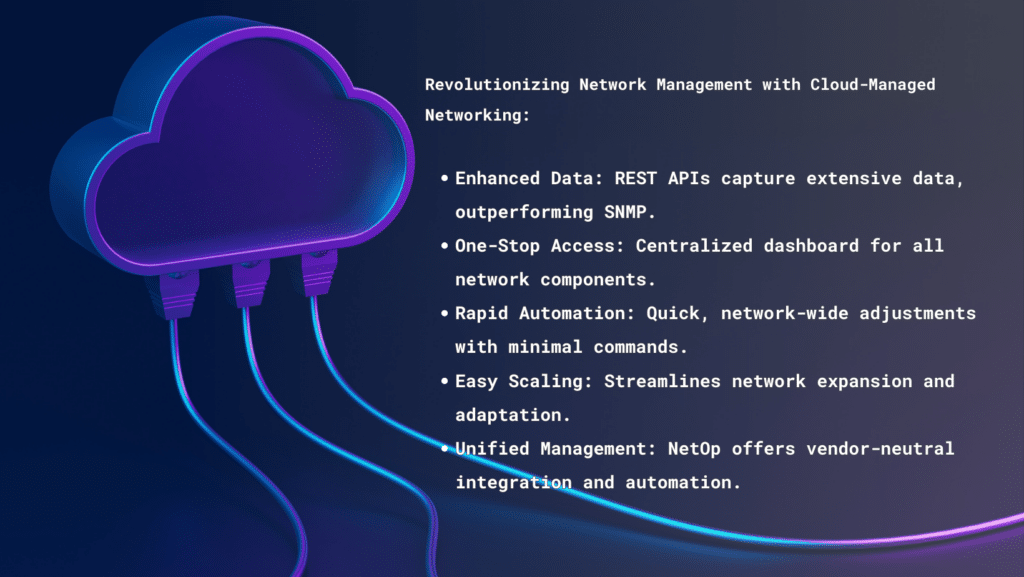What is the cloud-managed network trend, and how does it change network management?

There seems to be no end to the growth of networks, both in terms of size and complexity. As they expand, they tighten the screw of pressure on IT directors and network operations teams. Even small errors can snowball into serious outages that disrupt business operations, while expectations for network performance and availability continue to rise.
There’s no choice but to find ways to streamline, simplify, and speed up network management tasks, which means using the famous saying of working smarter, not just harder. Cloud-managed networking is the vital new tool that empowers netops teams to do just that.
In this article, we’ll explain what cloud-managed networking is, and how it can change the atmosphere for overstretched network management teams.
The drawbacks of traditional network management
Traditionally, network monitoring was carried out by installing an agent onto the premises where the network is hosted. It applied Simple Network Management Protocol (SNMP) to pull data directly from each device on the network to a management information base (MIB). These devices, which only support SNMP monitoring, are now called legacy devices, even though many of them are still in use.
Although each vendor would have different policies, every MIB would cover a certain minimum number of fields, such as device name and IP, port information, and port metrics. It’s an enormous amount of data for network managers to handle, but it’s also often disappointingly thin.
Recommended reading: The Up & Coming Generation of Network Performance Monitoring, What To Expect
Most of the traditional SNMP MIBs provide data about the physical layer, without getting into the networking or application layers. This can leave network managers in the dark about much of the activity on the network, making it much harder and more time-consuming for them to carry out root cause analysis, investigate and remediate incidents, and make decisions about network improvements.
What is cloud-managed networking?
Cloud-managed networking stands in contrast to legacy devices. It uses REST API to communicate with each device on the network, and pull data through HTTP protocols to a network controller located in the cloud.
This way, your vendor provides you with data about the network conditions, metrics, alerts, and more in a single centralized location. By now, almost every reputable vendor offers a cloud-managed networking solution, including Cisco Meraki, Juniper Mist, HPE Aruba, Fortinet, and more.
Even solutions that are not cloud managed will often use REST APIs, simply because they provide more information and greater control. However the main prerequisite for cloud managed networking is that your devices communicate with REST API.

The impact of cloud-managed networking on network management
As mentioned above, legacy devices only gather a thin layer of data. A REST API collects almost all the same data as SNMP protocols, plus a lot more besides. It’s estimated that SNMP gathers only around 30% of the data that REST APIs can provide. SNMP might deliver a single layer of data, while the REST API provides information about deeper levels of communication like tunnels and VPNs.
Being able to access data in a single location is also a significant advantage. If, for example, you get an alert about reduced speeds on your network, you can go to the network controller and check data about all your switches, firewalls, access points, and more in one go, instead of searching through a number of databases individually.
Recommended reading: Network Notifications – Learn How To Focus On Alerts That Matter
Once network data is centralized, it also becomes possible to apply automation for network monitoring, network management, incident response, and more. Cloud-managed networking can apply adjustments across the entire network in a few minutes, and with just one set of commands. In contrast, if you wanted to grant wifi access to 300 devices for example, it could take you days to manually configure all the switches, firewalls, access points, etc.
Network automation speeds up management requirements, freeing IT directors and netops teams to scale their networks at will and enabling them to be far more responsive to fluctuating business needs. It also helps reduce costs involved and untie some of the complexity that makes network management so challenging.
How NetOp can help with cloud-managed networking
Cloud-managed networking is a massive step forwards for network management, but there are still a number of challenges that remain. Each of the main vendors offers their own network controllers which only collect data from their own devices. There’s typically no connection between controllers from different vendors.
That means that if, for example, your network includes devices from Cisco Meraki, HPE Aruba, and Forticloud, you’d need to keep track of three different network controllers. Unless you use NetOp. NetOp is vendor-agnostic, so it communicates with all your controllers, correlates data, and brings it all together into a single pane of glass. NetOp also automates configurations across multiple controllers, to streamline the process of making changes to your network.
Cloud-managed networking is the future
Network managers and IT directors are seeking ways to ease the burden of network management from their stressed teams. Cloud-managed networking, with its centralized data, richer information, and streamlined automation, is the secret sauce they’ve been looking for. As cloud-managed solutions continue to develop and improve, the support they provide will only increase.
Find out what NetOp can do to help you with cloud-managed networking !

